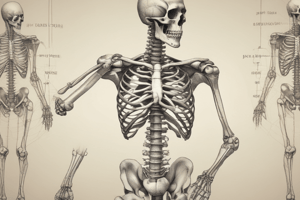Podcast
Questions and Answers
What type of joint is the hip joint?
What type of joint is the hip joint?
- Hinge joint
- Pivot joint
- Ball-and-socket joint (correct)
- Gliding joint
Which muscle is responsible for knee extension?
Which muscle is responsible for knee extension?
- Calf muscles
- Gluteal muscles
- Hamstrings
- Quadriceps (correct)
What is the function of the patella?
What is the function of the patella?
- To connect the femur to the tibia
- To increase the force of the hamstrings
- To increase the force of the quadriceps (correct)
- To stabilize the ankle joint
What is the main function of the gluteal muscles?
What is the main function of the gluteal muscles?
What is the femoral artery responsible for?
What is the femoral artery responsible for?
What is the tibial nerve responsible for?
What is the tibial nerve responsible for?
Flashcards are hidden until you start studying
Study Notes
Bones of the Lower Limb
- Femur (Thigh Bone):
- Longest bone in the body
- Connects hip joint to knee joint
- Divided into three parts: proximal, shaft, and distal
- Patella (Kneecap):
- Triangular bone that sits at the front of the knee joint
- Acts as a mechanical fulcrum to increase the force of the quadriceps muscle
- Tibia (Shin Bone):
- Medial and larger of the two bones in the lower leg
- Bears the body's weight
- Fibula:
- Lateral and smaller of the two bones in the lower leg
- Plays a role in stabilizing the ankle joint
Joints of the Lower Limb
- Hip Joint:
- Ball-and-socket joint that connects the femur to the pelvis
- Allows for flexion, extension, abduction, adduction, rotation, and circumduction
- Knee Joint:
- Hinge joint that connects the femur to the tibia
- Allows for flexion and extension
- Ankle Joint:
- Hinge joint that connects the tibia and fibula to the foot
- Allows for dorsiflexion and plantarflexion
Muscles of the Lower Limb
- Gluteal Muscles:
- Gluteus maximus, gluteus medius, and gluteus minimus
- Responsible for extension, abduction, and external rotation of the hip joint
- Quadriceps:
- Rectus femoris, vastus lateralis, vastus medialis, and vastus intermedius
- Responsible for knee extension
- Hamstrings:
- Biceps femoris, semitendinosus, and semimembranosus
- Responsible for knee flexion
- Calf Muscles:
- Gastrocnemius and soleus
- Responsible for plantarflexion of the ankle joint
Blood Vessels and Nerves of the Lower Limb
- Femoral Artery:
- Major artery that supplies oxygenated blood to the lower limb
- Divides into the popliteal artery behind the knee
- Femoral Nerve:
- Major nerve that supplies sensation and motor function to the anterior thigh
- Divides into several branches that supply the lower limb
- Tibial Nerve:
- Major nerve that supplies sensation and motor function to the posterior leg and foot
- Divides into the medial and lateral plantar nerves in the foot
Studying That Suits You
Use AI to generate personalized quizzes and flashcards to suit your learning preferences.



